Bittensor: AI Subnets Redefining Collective Intelligence

Background of the AI Revolution
The Rise of AI
With the rapid development of artificial intelligence (AI) technology, we are entering a new era driven by data. Breakthroughs in fields such as deep learning and natural language processing have made AI applications ubiquitous.
The birth of ChatGPT in 2022 ignited the AI industry, leading to a series of AI tools for tasks like video creation and automated office work, and the concept of “AI+” is now on the agenda. The market value of the AI industry has also soared, expected to reach $185 billion by 2030.

Traditional Internet Companies’ Monopoly on AI
Currently, the AI industry is dominated by companies like Nvidia, Microsoft, Google, and OpenAI. While technological advancements have brought about centralization of data and uneven distribution of computing resources, Web3’s decentralized philosophy offers new possibilities to address these issues. In the distributed network of Web3, the current AI development landscape is poised to be reshaped.
Progress of Web3+AI
Amid the AI industry boom, many high-quality Web3+AI projects have emerged. Fetch.ai uses blockchain technology to create a decentralized economy, supporting autonomous agents and smart contracts to optimize AI model training and applications.
Numerai uses blockchain technology and a community of data scientists to predict market trends and incentivizes model developers through reward mechanisms. Velas builds a high-performance smart contract platform combining AI and blockchain, offering faster transaction speeds and higher security.
AI projects themselves include three major elements: data, algorithms, and computing power. While the Web3+data and Web3+computing power tracks are thriving, the Web3+algorithm direction has been fragmented, leading to projects that only form single-direction applications.
Bittensor addresses this gap by building an AI algorithm platform with a built-in selection and competition mechanism through blockchain’s inherent competitive and incentive structures, preserving the best AI projects.
Development Path of Bittensor
Innovative Breakthroughs
Bittensor is a decentralized incentivized machine learning network and digital goods marketplace.
- Decentralization: Bittensor operates on a distributed network of thousands of computers controlled by different companies and organizations, solving problems like data centralization.
- Fair Incentive Mechanism: The Bittensor network provides $TAO tokens proportional to the contribution of its subnets, and subnets reward their miners and validators proportional to their node contributions.
- Machine Learning Resources: The decentralized network can serve every individual needing machine learning computational resources.
- Diverse Digital Goods Market: Initially designed for trading machine learning models and related data, the Bittensor network’s digital goods market has expanded to trade any form of data, thanks to the network’s expansion and Yuma consensus mechanism that doesn’t concern the data’s substance.
Development Timeline
Unlike many high-valuation VC projects currently in the market, Bittensor is a more equitable, intriguing, and meaningful geek project. Its development process lacks the typical “overpromising to attract investments” approach seen in other projects.
- Concept Formation and Project Launch (2021): Created by a group of enthusiasts and experts dedicated to advancing decentralized AI networks, Bittensor was built using the Substrate framework to ensure its flexibility and scalability.
- Early Development and Technical Validation (2022): The team released the Alpha version to verify the feasibility of decentralized AI, introducing the Yuma consensus that emphasizes the principle of data agnosticism to maintain user privacy.
- Network Expansion and Community Building (2023): The team released the Beta version and introduced the token economic model (TAO) to incentivize network maintenance.
- Technological Innovation and Cross-chain Compatibility (2024): The team utilized DHT (Distributed Hash Table) integration technology for more efficient data storage and retrieval. The project also began focusing on promoting and further expanding subnets and the digital goods market.
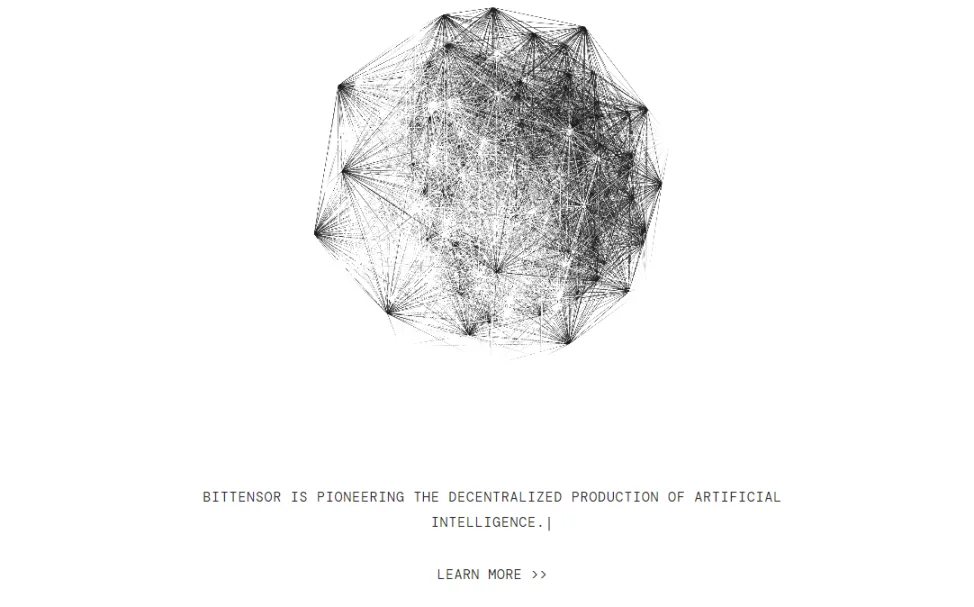
Throughout its development, Bittensor avoided significant traditional VC involvement, mitigating the risk of centralized control. The project incentivizes nodes and miners through tokens, ensuring the network’s vitality. Essentially, Bittensor is a GPU miner-driven AI computing power and service project.
Token Economics
The Bittensor network’s token is TAO, which, in homage to Bitcoin, shares several similarities with BTC. The total supply is 21 million, with a halving event every four years. TAO tokens were distributed through a fair launch at the network’s inception, with no pre-mining or token reservations for the founding team or VCs.
Currently, a Bittensor network block is generated approximately every 12 seconds, with each block rewarding 1 TAO token, resulting in roughly 7,200 TAO generated daily. These rewards are distributed proportionally to each subnet’s contribution and within the subnet to owners, validators, and miners.
TAO tokens can be used to purchase and access computing resources, data, and AI models on the Bittensor network and serve as a credential for participating in community governance.
Current Development Status
The Bittensor network currently boasts over 100,000 accounts, with more than 80,000 non-zero balance accounts.
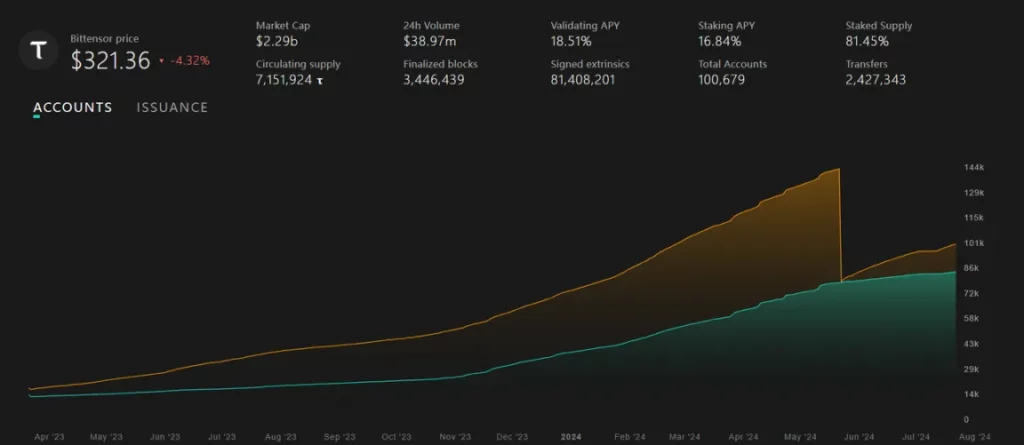
In the past year, TAO has surged by several multiples, with a current market capitalization of $2.278 billion and a price of $321.
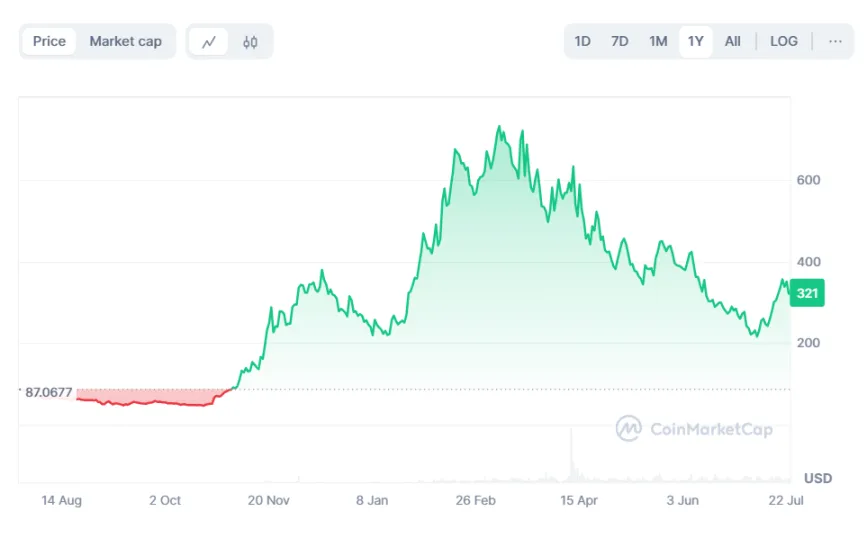
Gradually Implemented Bittensor Subnet Architecture
Bittensor Protocol
The Bittensor protocol is a decentralized machine learning protocol that facilitates the exchange of machine learning capabilities and predictions among network participants and promotes the sharing and collaboration of machine learning models and services in a peer-to-peer manner.
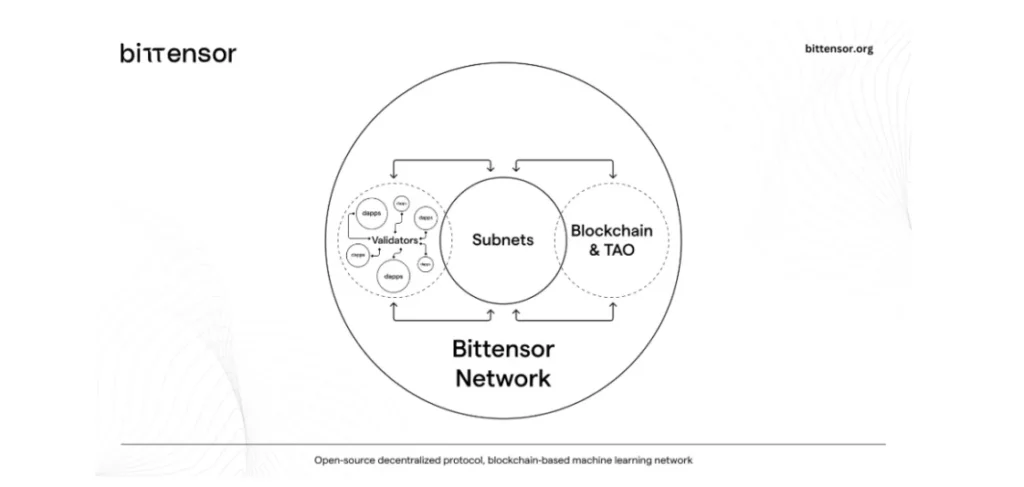
The Bittensor protocol includes network architecture, subtensor, subnet architecture, and roles within the subnet ecosystem such as validator nodes and miner nodes. The Bittensor network fundamentally consists of nodes participating in the protocol, each running Bittensor client software to interact with other network nodes.
These nodes are managed by subnets, which employ a survival-of-the-fittest mechanism where poorly performing subnets are replaced by new ones, and poorly performing validator and miner nodes within subnets are also eliminated. Thus, subnets are a crucial component of the Bittensor network architecture.
Subnet Logic
A subnet can be viewed as an independently running code segment that establishes unique user incentives and functionalities, while maintaining the same consensus interface as the Bittensor mainnet. Subnets include local subnets, testnet subnets, and mainnet subnets.
Apart from the root subnet, there are currently 45 subnets, with the number expected to grow from 32 to 64 between May and July 2024, with four new subnets added each week.
Roles and Emissions in Subnets
The Bittensor network comprises six functional roles: users, developers, miners, staker validators, subnet owners, and committees. Within a subnet, roles include subnet owners, miners, and staker validators.
- Subnet Owners: Responsible for providing basic miner and validator code, setting unique additional incentive mechanisms, and distributing miner work incentives.
- Miners: Miners are encouraged to iterate server and mining code to stay competitive within the same subnet. The lowest-emission miners will be replaced by new miners and need to re-register their nodes. Notably, miners can run multiple nodes in multiple subnets.
- Validators: Validators measure the contribution of each subnet and ensure its correctness, earning corresponding rewards. They can stake TAO tokens on validator nodes, with validator nodes receiving 0-18% (adjustable) staking rewards.
Subnet emissions refer to the TAO token distribution mechanism rewarding miners and validators. Typically, 18% of the subnet’s emission reward goes to the subnet owner, 41% to validators, and 41% to miners. A subnet contains 256 UID slots, with 64 slots allocated to validators and 192 to miners.
Only the top 64 stakers can obtain validator permissions and be considered active validators in the subnet. Validator staking volume and performance determine their status and rewards within the subnet. Miners’ performance is scored through requests and evaluations by subnet validators, with underperforming miners replaced by new miners.
Thus, the more tokens validators stake and the more efficient miners’ computations, the higher the subnet’s total emissions and ranking.
Subnet Registration and Elimination
Upon registration, a subnet enters a 7-day immunity period. The initial registration fee is 100 $TAO, and the price doubles for re-registration, though it gradually returns to 100 $TAO over time. When all subnet slots are filled, a new subnet registration will result in the elimination of the one with the lowest emissions that is not in its immunity period. Therefore, subnets need to maximize the staked amount in UID slots and miner efficiency to avoid being eliminated post-immunity.
Benefiting from Bittensor’s subnet architecture, the decentralized AI data network Masa has been established, becoming the first dual-token reward system within the Bittensor network, attracting $18 million in funding.
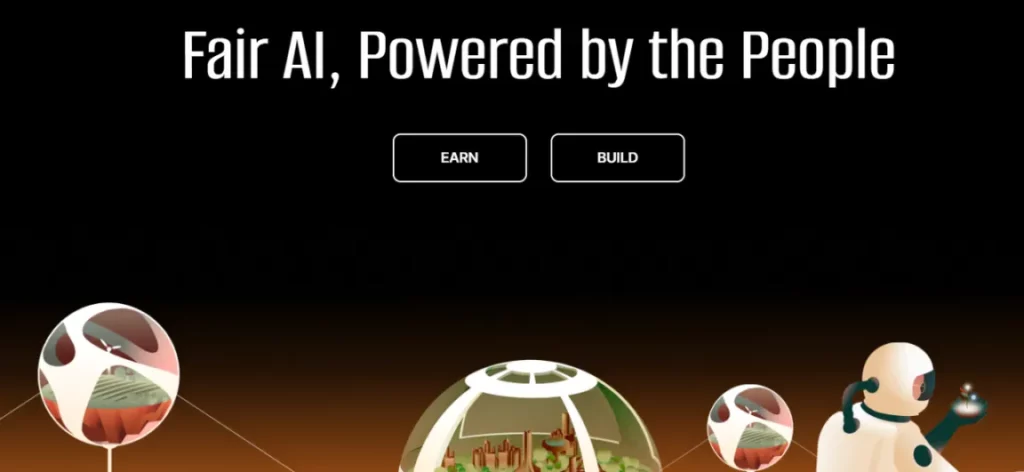
Consensus and Proof Mechanisms
The Bittensor network incorporates multiple consensus and proof mechanisms. In traditional decentralized networks, miner nodes often utilize PoW (Proof of Work) to ensure their contribution to the network, receiving rewards based on computing power and data processing quality.
For validator nodes, PoV (Proof of Validation) is commonly used to ensure network security and integrity. Bittensor introduces a unique PoI (Proof of Intelligence) mechanism alongside the Yuma consensus to facilitate validation and reward distribution.
Proof of Intelligence Mechanism
Bittensor’s PoI mechanism is an innovative validation and incentive system that ensures network security, data quality, and efficient utilization of computing resources by validating participants’ contributions through intelligent computational tasks.
- Miner nodes prove their work by completing intelligent computing tasks such as natural language processing, data analysis, and machine learning model training.
- Tasks are assigned by validators to miners, who return the results to validators for scoring based on task completion quality.
Yuma Consensus
Yuma consensus is the core mechanism of the Bittensor network. After validators score task completion, they input the scores into the Yuma consensus algorithm. In this algorithm, validators with higher staked TAO weights have greater influence, and outlier results are filtered out. The system then allocates token rewards based on comprehensive scoring.
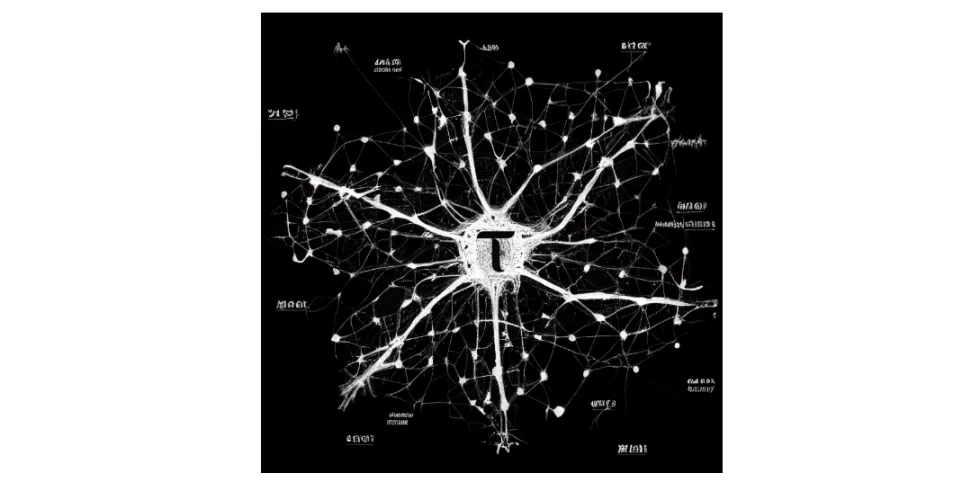
- Data Agnosticism: Ensures privacy and security in data processing, allowing nodes to perform computations and validations without knowing the actual data content.
- Performance-Based Rewards: Rewards are distributed based on node performance and contribution, ensuring efficient and high-quality computation and data processing.
MOE Mechanism Collaboration
Bittensor introduces the MOE (Mixture of Experts) mechanism, integrating multiple expert-level sub-models within a single model architecture. Each expert model has a relative advantage in solving specific domain problems. When new data is introduced, different sub-models collaborate to achieve better results than a single model.
Under the Yuma consensus, validators can also score expert models, rank their capabilities, and allocate token rewards, incentivizing model optimization and improvement.
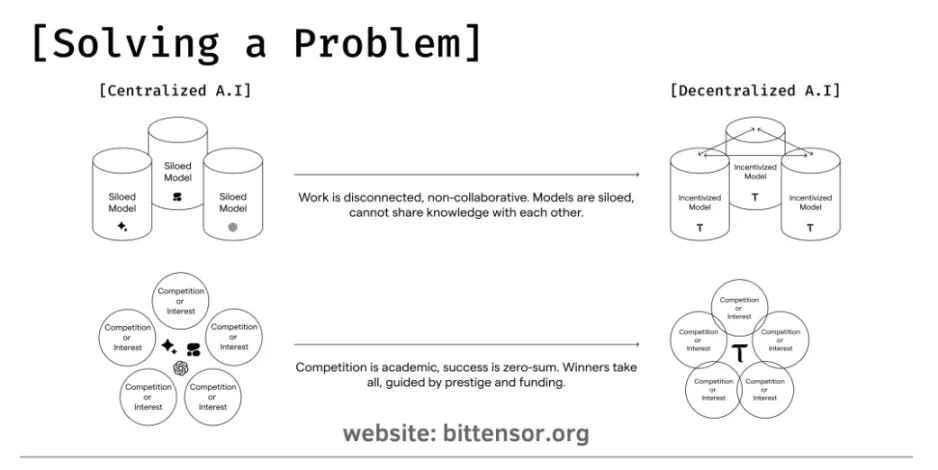
Bittensor Subnet Projects
As of this writing, Bittensor has 45 registered subnets, with 40 named. In the past, subnet registration competition was intense, with fees reaching up to a million dollars. Currently, Bittensor is gradually opening more subnet registration slots.
Newly registered subnets may not match the stability and model efficacy of long-running ones. However, Bittensor’s elimination mechanism ensures a process where higher-quality subnets outcompete lower-quality ones over time.
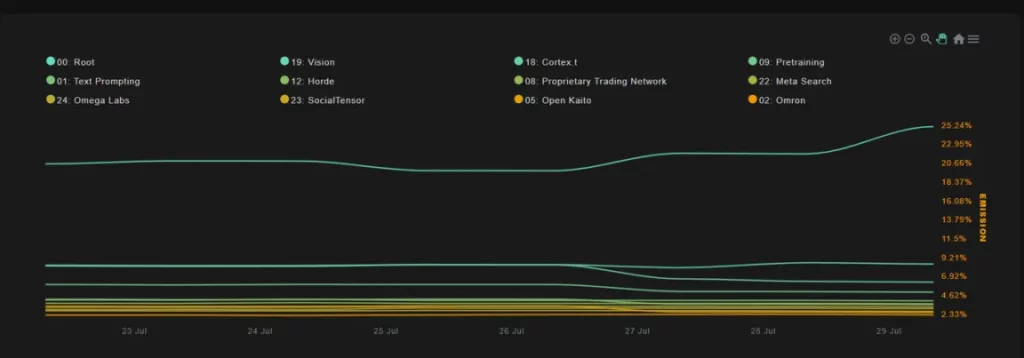
Excluding the root subnet, subnets 19, 18, and 1 have garnered significant attention, with emission shares of 8.72%, 6.47%, and 4.16%, respectively.
Subnet 19
Subnet 19, named Vision, was registered on December 18, 2023. Vision focuses on decentralized image generation and inference, providing access to open-source LLMs, image generation models, and other miscellaneous models trained on the subnet 19 dataset.
- Registration Fee: 3.7 TAO
- 24-hour Node Revenue: Approximately 627.84 TAO
- 24-hour Node Recovery: Approximately 64.79 TAO
- Daily Average Node Revenue: 2.472 TAO (approximately $866)
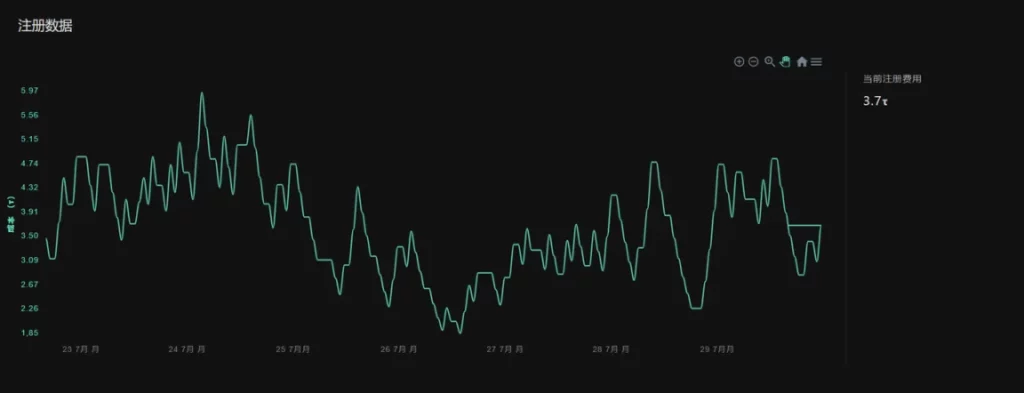
Currently, Vision subnet recovers a total node value of about 19,200 TAO.
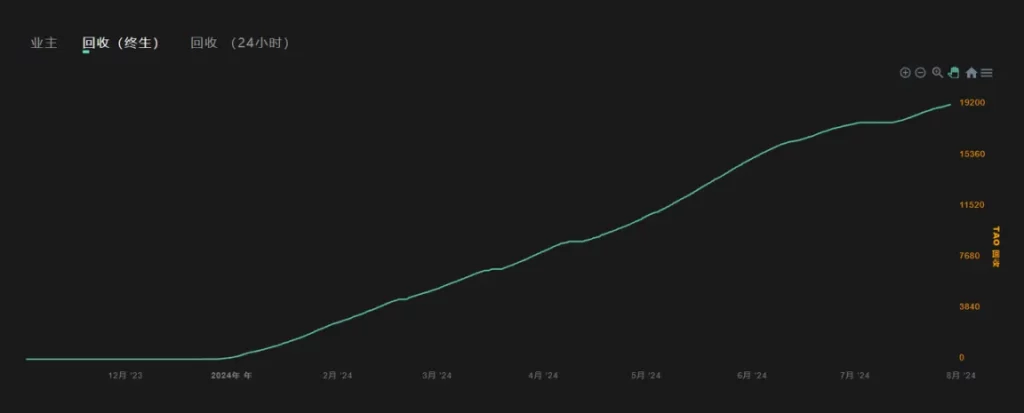
Subnet 18
Subnet 18, named Cortex.t, developed by Corcel, aims to build a cutting-edge AI platform offering reliable, high-quality text and image responses via API.
- Registration Fee: 3.34 TAO
- 24-hour Node Revenue: Approximately 457.2 TAO
- 24-hour Node Recovery: Approximately 106.32 TAO
- Daily Average Node Revenue: 1.76 TAO (approximately $553.64)
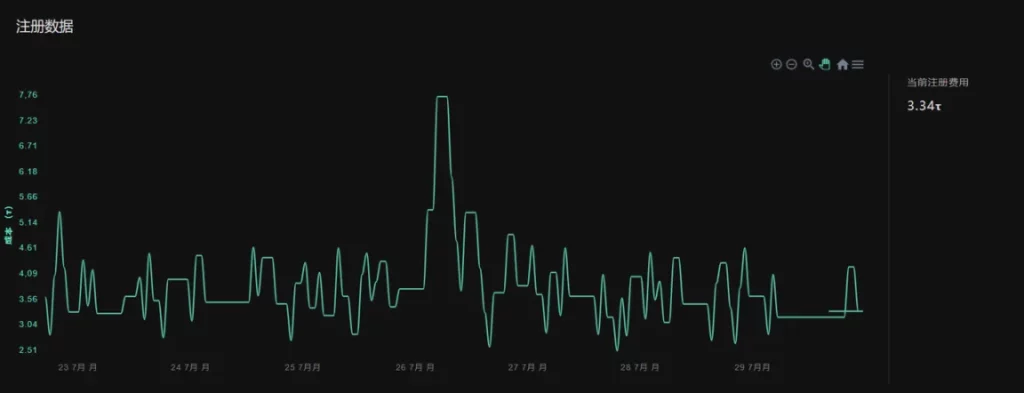
Currently, Cortex.t subnet recovers a total node value of about 27,134 TAO.
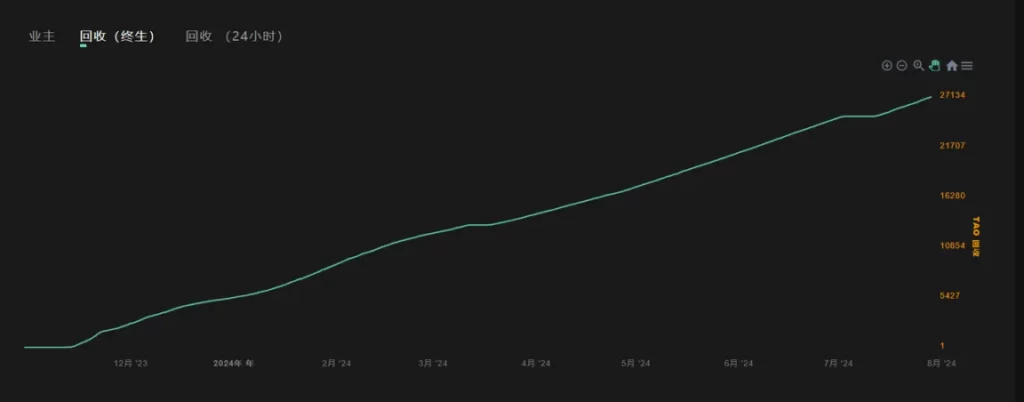
Subnet 1
Subnet 1, developed by the Opentensor Foundation, specializes in text generation within a decentralized subnet. As the first Bittensor subnet project, it faced significant skepticism. In March, Taproot Wizards founder Eric Wall referred to TAO tokens as meme coins in the AI field, pointing out that subnet 1’s text problem-solving approach with numerous AI nodes did not effectively enhance problem-solving outcomes.
Other Subnets
Among the other subnets, there are large data processing models, trading AI models, and more. For instance:
- Subnet 22 Meta Search: Analyzes Twitter data to provide market sentiment.
- Subnet 2 Omron: Optimizes staking strategies using deep neural networks.
Future Development
From a heat perspective, the AI concept rivals that of Web3, attracting substantial investment. Web3 + AI will likely remain a market focus for a considerable time.
From a project structure perspective, Bittensor is not a traditional VC project. Since its launch, the project has appreciated significantly, combining technical and market support.
From a technical innovation perspective, Bittensor breaks the isolation of past Web3 + AI projects. Its unique subnet architecture lowers the barriers for AI teams to migrate to decentralized networks, quickly gaining returns. The competition and elimination mechanisms require subnets to continually optimize models and increase staking to avoid being outcompeted by new subnets.
From a risk perspective, increasing subnet slots lowers registration barriers, potentially inviting lower-quality projects. As subnet numbers grow, the TAO rewards for existing subnets will decrease. If TAO token prices do not rise in tandem with subnet numbers, expected returns may fall short.